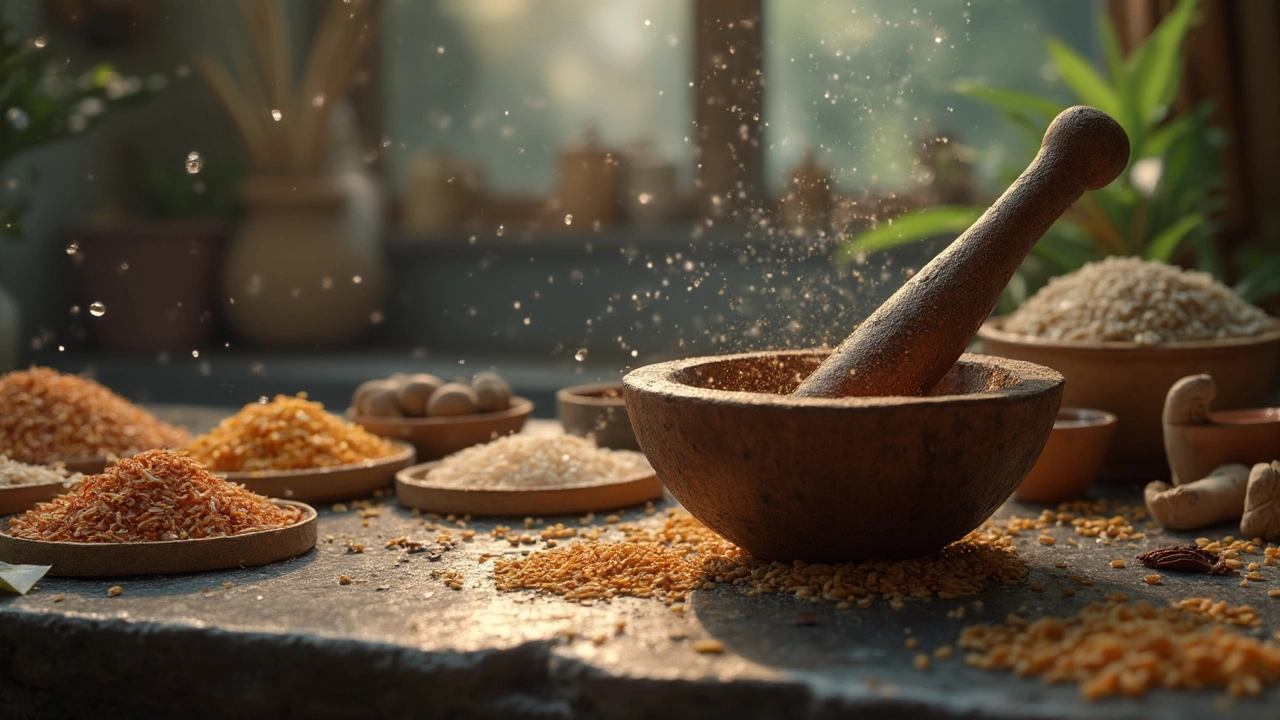Boost Dosa Batter Fermentation Naturally Without Yeast
 Feb, 15 2025
Feb, 15 2025
Ever wondered how to speed up dosa batter fermentation without reaching for the yeast? Let's talk about getting that dreamy, fluffy dosa without any shortcuts that involve yeast. You might think it's a bit of a challenge, but it’s simpler than it seems, especially when nature has your back.
Temperature plays a big role here. A warmer spot in your kitchen can work wonders. Ever thought of using the oven light? It acts like a little sun just for your batter, keeping it nice and cozy.
Now, let's not forget the powers of natural boosters. Think of adding a handful of cooked rice or even fenugreek seeds into the mix. They can really aid in kick-starting the fermentation process.
- Introduction to Dosa Batter
- Role of Temperature
- Natural Fermentation Boosters
- Choosing the Right Vessel
- Troubleshooting Tips
Introduction to Dosa Batter
If you've ever craved a plate of crispy, golden-brown dosas, you've probably wondered what makes them so light and yummy. The secret lies in the dosa batter. This magical mixture of rice and lentils is the cornerstone of authentic South Indian cuisine. Getting it just right is key for those perfect, delicious discs we all love.
Dosa batter is essentially made from rice and urad dal (black gram). The traditional process starts with soaking these two staples separately. The rice provides the crispiness, while urad dal adds the soft texture and helps with fermentation. Once soaked, they are ground to a smooth paste, combining both components in a ratio usually around 3:1, rice to dal, but that can vary depending on personal taste.
The Fermentation Process
Here’s where the magic happens: fermentation! By leaving the batter out overnight or about 8-12 hours, a transformation occurs. This fermentation is not just about puff and airiness. It also enhances the batter's nutritional profile, making the dosas easier to digest and giving them that signature tangy flavor. Yeast isn't part of the traditional method, which means the natural process relies on wild microbes present in the environment and the ingredients themselves.
Why Yeast-Free?
Staying yeast-free means keeping things natural. Yeast-free batters honor the age-old techniques, which are often healthier and more gut-friendly. Plus, for those who prefer avoiding commercial yeast for dietary reasons, sticking to traditional methods offers peace of mind.
Mastering the art of dosa batter is part patience, part awareness of ideal conditions. Knowing when your batter is just right might take a few tries, but with the right conditions and a bit of kitchen intuition, you'll be whipping up fabulous dosas in no time. Get ready to transform your kitchen into a little piece of South India!
Role of Temperature
When it comes to fermenting dosa batter, temperature is like that extra boost of motivation your batter needs to bubble up beautifully. The temperature of your surroundings can make or break the fermentation process.
Finding the Sweet Spot
Ideally, you want to keep the temperature around 30°C (86°F) for optimal fermentation. Think about it as the batter's comfort zone. If your kitchen struggles to maintain this warmth, no worries. You can create a snug environment by turning on your oven light or simply placing the fermenting bowl near a warm appliance.
Too Cold or Too Hot?
If it's too cold, the batter might just drag its feet and take forever to ferment. Too hot? You risk the batter going sour too fast. Monitoring the room temperature can help you out here. A kitchen thermometer can be your best friend in tracking how cozy your batter's habitat is.
Practical Hacks
- Try wrapping the bowl with a towel to trap in the warmth.
- Placing the bowl in an oven with only the light on can mimic an incubator.
- If you live in colder climates, you can use a heating pad set on low beneath the bowl.
A small change can make a huge difference! Trust your senses; if the batter smells nice and sour after a day, you've cracked the fermentation code!

Natural Fermentation Boosters
When it comes to giving your dosa batter that extra push towards perfect fermentation, the kitchen has plenty of natural helpers. You don't need yeast to get those delicious, crispy dosas.
The Power of Cooked Rice
Adding a handful of cooked rice to your batter can do wonders. It’s not just a trick your grandma used; it’s science! Cooked rice provides extra carbohydrates, making it easier for bacteria to work their magic.
Benefits of Fenugreek Seeds
Have you ever wondered why your grandma always added fenugreek seeds? It’s not just for the slightly tangy taste; fenugreek seeds release natural compounds that speed up fermentation. So, you get that lovely texture and a bit more flavor.
Using Flattened Rice (Poha)
Poha or flattened rice is another secret ingredient. Just a small amount can boost the fermentation thanks to its ability to soak up water, acting as a catalyst in the process.
- Add a handful of cooked rice for extra carbohydrates.
- Use a teaspoon of fenugreek seeds to help in safe and quick fermentation.
- Try incorporating a bit of poha for better consistency.
These natural ingredients not only improve the fermentation but also enhance the flavor, giving you dosas that are both tasty and perfectly fluffy.
Choosing the Right Vessel
Picking the right vessel for fermenting your dosa batter is more crucial than you might think. It’s not just about holding the batter; it’s about creating the perfect environment for natural fermentation to thrive.
Material Matters
First off, let's talk about material. Traditionally, people use ceramic or earthenware because they're slightly porous, allowing the batter to breathe and ferment more effectively. But, if you don't have those, don't sweat it. Glass or stainless steel can work too, just avoid plastic as it can sometimes trap odors and isn't the best for long-term fermentation.
Size Does Count
When it comes to size, choose a vessel that's big enough to hold double the amount of batter you've prepared. Fermentation will make your batter rise and you don't want an overflow mess to clean up. So, better give it some room.
The Cover's Role
Now, you might be tempted to seal that vessel tight. Don’t. A loose cover is your friend here, allowing a bit of air passage which helps in the fermentation process. A lightweight lid or even a cloth secured with a rubber band works perfectly.
Keep it Clean
Before pouring your batter in, double-check the cleanliness of your vessel. Any residue from previous meals can throw off the flavors and the fermentation.
Choosing the right vessel takes a bit of attention, but once you get it right, it sets you up for some reliably great dosa. Just pop your dosa batter in the right container and let the magic happen!

Troubleshooting Tips
So, you’ve tried your hand at fermenting dosa batter naturally and hit a few bumps along the way? Don’t worry, we've all been there. Here’s how you can troubleshoot the fermentation process and get back on track.
1. Batter Not Rising?
One of the most common issues is when the batter seems lackluster, not rising as you hoped. First things first, check the temperature. When it’s too cold, the fermentation slows down. Do you have a warm spot in your house like near your oven or just under those warm kitchen lights? That’s where your batter should hang out.
"The key to a perfect fermentation lies in achieving a symbiotic balance between warmth and natural ingredients," says renowned chef Vikas Khanna.
2. Batter Smells Odd?
If your dosa batter starts smelling funky, it probably needs a bit more care. Maybe you left it out a tad too long or the temperature was too high. Try placing it in the fridge once it reaches the right level of fermentation. This way, you'll keep those unwanted odors at bay.
3. Batter Too Thick?
A thick batter can adversely affect the crispiness of your dosas. If it’s too gooey, add a bit of water slowly. Here's a quick test: the batter should flow easily off a ladle but still have a bit of body.
4. Excess Bubbling?
Sometimes, overenthusiastic fermentation leads to too many bubbles. While bubbles are great, too much can mean the balance of rice and lentils is off. Ensure your rice-to-lentil ratio stays around 3:1 for better texture.
| Issue | Solution |
|---|---|
| Batter Not Rising | Increase temperature; try warmer spots. |
| Odd Smell | Refrigerate once fermented to right level. |
| Thick Batter | Gradually add water for better consistency. |
With these tips, you should be well-equipped to tackle any fermentation hiccups that come your way. Remember, practice makes perfect, and a few adjustments here and there will help you achieve the dosa batter of your dreams.